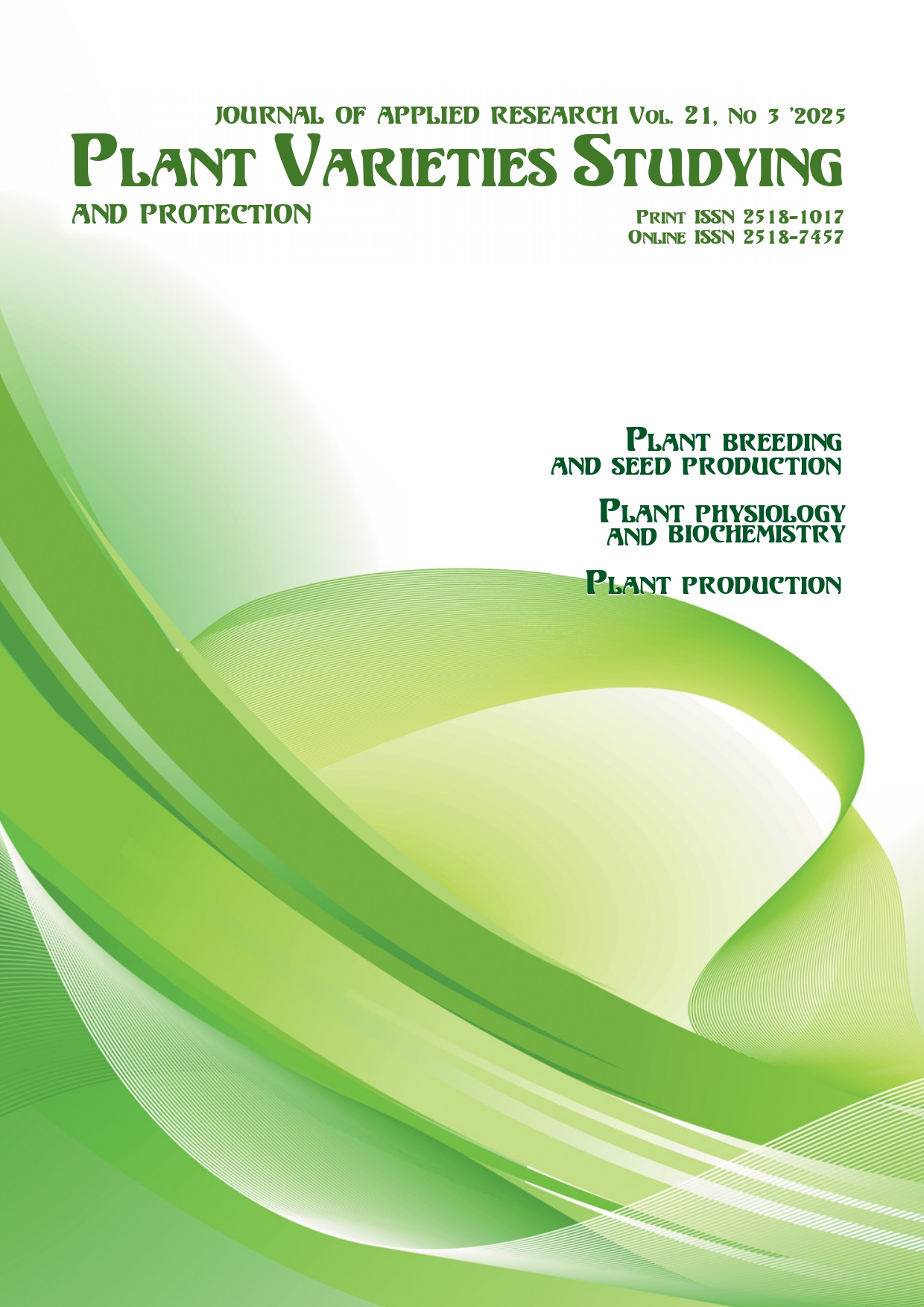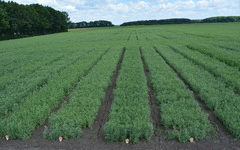Proline content and lectin activity in different soybean varieties during reproductive phases of development
DOI:
https://doi.org/10.21498/2518-1017.21.3.2025.339314Keywords:
soybean, lectins, free proline, adaptive potentialAbstract
Purpose. To investigate the content of free proline and lectin activity in soybean (Glycine max L.) of different varieties during the phases when they are most sensitive to moisture: the beginning and full flowering, and the formation and filling of beans. Methods. The research focused on the leaves from the two upper nodes of plants of 17 soybean varieties of domestic and foreign breeding. Free proline content was determined using a spectrophotometric method and lectin activity was determined using haemagglutination of trypsinised blood erythrocytes. The research results were statistically analysed using LibreOffice Calc (GNU Lesser General Public Licence v3). Results. Screening soybean varieties for proline content and lectin activity in plant leaves revealed varietal differences in reproductive phase development according to these indicators. These were significantly higher during the bean formation and filling stage than at the beginning and full flowering stage. A high correlation coefficient (r = 0.72 at P = 0.05) was found between moisture content and lectin activity during the bean formation and filling phase. Conclusions. Changes in proline content and lectin activity were observed during the three phases of plant development. The highest values were recorded during the formation and filling stages of bean development. This suggests that soybeans activate adaptive responses under unfavourable growing conditions, particularly drought. The results obtained allow us to recommend measuring lectin activity and proline content in plant leaves during the formation and filling stages of beans as an additional way of studying the adaptive potential of soybean varieties.
Downloads
References
Zhao, J., Wang, Y., Zhao, M., Rodriguez, D., de Voil, P., Tan, Z., & Chu, Q. (2025). Anticipated changes in soybean drought stress and yield stability under future climates in Northeast China. Npj Sustainable Agriculture, 3(1). https://doi.org/10.1038/s44264-025-00053-5
Pysarenko, V. M., Pysarenko, P. V., Pysarenko, V. V., Gorb, O. O., & Chaika, T. O. (2019). Droughts in the context of climate changes in Ukraine. Bulletin of Poltava State Agrarian Academy, 1, 134–146 [In Ukrainian]
Vaghar, M. S., Sayfzadeh, S., Zakerin, H. R., Kobraee, S., & Valadabadi, S. A. (2020). Foliar application of iron, zinc, and manganese nano-chelates improves physiological indicators and soybean yield under water deficit stress. Journal of Plant Nutrition, 43(18), 2740–2756. https://doi.org/10.1080/01904167.2020.1793180

Zhang, Y., Zhang, H., Fu, J., Du, Y., Qu, J., Song, Y., & Wang, P. (2021). The GmXTH1 gene improves drought stress resistance of soybean seedlings. Molecular Breeding, 42(1). https://doi.org/10.1007/s11032-021-01258-5
 |
| 
Belyavskaya, L. G., Belyavsky, Y. V., & Dianova, A. A. (2018). Assessment of ecological stability and plasticity of soybean varieties. Leguminous and Cereal Crops, 4, 42–49. https://doi.org/10.24411/2309-348X-2018-11048
Osman, M. E. M., Osman, R. S. H., Ghartey‐Kwansah, G., & Konozy, E. H. E. (2023). Plant Lectins: Implications in Tolerance and Resistance. In Annual Plant Reviews online (pp. 31–55). Wiley. https://doi.org/10.1002/9781119312994.apr0804

Моlodchenkova, О. О., & Ryshchakova, O. V. (2019). Participation of lectins in the formation of plant protective reaction of cereals. New stages of development of modern science in Ukraine and EU countries (pp. 205–230). Baltija Publishing.
Spadoro-Tank, J. P., & Etzler, M. E. (1988). Heat shock enhances the synthesis of a lectin-related protein in Dolichos biflorus cell suspension cultures. Plant Physiology, 88(4), 1131–1135. https://doi.org/10.1104/pp.88.4.1131
Kaur, G., & Asthir, B. (2015). Proline: a key player in plant abiotic stress tolerance. Biologia Plantarum, 59(4), 609–619. https://doi.org/10.1007/s10535-015-0549-3

Renzetti, M., Funck, D., & Trovato, M. (2024). Proline and ROS: A Unified Mechanism in Plant Development and Stress Response? Plants, 14(1), Article 2. https://doi.org/10.3390/plants14010002
 |
| 
Hossain, M. M., Liu, X., Qi, X., Lam, H.-M., & Zhang, J. (2014). Differences between soybean genotypes in physiological response to sequential soil drying and rewetting. The Crop Journal, 2(6), 366–380. https://doi.org/10.1016/j.cj.2014.08.001

Sarkar, K., Mannan, M., Haque, M., & Ahmed, J. (2016). Physiological Basis of Water Stress Tolerance in Soybean. Bangladesh Agronomy Journal, 18(2), 71–78. https://doi.org/10.3329/baj.v18i2.28908
Sichkar, V. I., Lyashok, A. K., & Musych, V. M. (2001). Physiological response of soybean varieties to drought and elevated temperature. Physiology and Biochemistry of Cultivated Plants, 33(6), 497–503. [In Ukrainian]
Sichkar, V., Ganzhelo, O., & Lavrova, G. (2013). Increasing adaptability under the drought is the main direction of modern soybean breeding in the South of Ukraine. Journal of Lviv National Agrarian University. Agronomy, 17(2), 187–195. [In Ukrainian]
Mursakaev, E. S., Lavrova, G. D., Ganzhelo, O. I., & Bushulian, O. V. (2018). Estimation of parameters of environmental stability and plasticity of soybean varieties in the southern Steppe of Ukraine. Bulletin of the Center for Science Provision of Agribusiness in the Kharkiv region, 24, 173–180. [In Ukrainian]
Sichkar, V., & Lavrova, H. (2024). Breeding pulses to improve adaptive traits under conditions of general warming. Proceeding VIII International Scientific Conference “Genetics, Physiology and Plant Breeding” (pp. 201–207). Chisinau, Republic of Moldova. https://doi.org/10.53040/gppb8.2024.34
Lutsyk, M. F., Panasyuk, E. N., & Lutsyk, A. D. (1981). Lectins. Vyshcha Shkola.
Lowry, O. H., Rozebrough, N. I., Farr, F. L., & Randall, R. J. (1951). Protein measurement with the Folin phenol reagent. Journal of Biological Chemistry, 193(1), 265–275.
 |
| 
Bates, L. S., Walden, R. P., & Tear, G. D. (1973). Rapid determination of free proline for water-stress studies. Plant and Soil, 39, 205–210. https://doi.org/10.1007/BF00018060

Rasheed, A., Mahmood, A., Maqbool, R., Albaqami, M., Sher, A., Sattar, A., Bakhsh, G., Nawaz, M., Hassan, M. U., Al-Yahyai, R., Aamer, M., Li, H., & Wu, Z. (2022). Key insights to develop drought-resilient soybean: A review. Journal of King Saud University - Science, 34(5), Article 102089. https://doi.org/10.1016/j.jksus.2022.102089

Naithani, S., Komath, S. S., Nonomura, A., & Govindjee, G. (2021). Plant lectins and their many roles: Carbohydrate-binding and beyond. Journal of Plant Physiology, 266, Article 153531. https://doi.org/10.1016/j.jplph.2021.153531
 |
| 
Zhou, Q., Song, S., Wang, X., Yan, C., Ma, C., & Dong, S. (2022). Effects of drought stress on flowering soybean physiology under different soil conditions. Plant, Soil and Environment, 68(10), 487–498. https://doi.org/10.17221/237/2022-pse

Tian, Y., Li, X., Zhou, X., Qu, Z., Wang, X., & Dong, S. (2023). Effects of drought Stress on SOD activity and pro content in different parts of soybean leaves. Legume Research, 46(8), 995–1000. https://doi.org/10.18805/lrf-750

Masheva, V., Spasova-Apostolova, V., Aziz, S., & Tomlekova, N. (2022). Variations in proline accumulation and relative water content under water stress characterize bean mutant lines (P. vulgaris L.). Bulgarian Journal of Agricultural Science, 28(3), 430–436.
Ryshchakova, O. V., Molodchenkova, O. O., & Petrov, S. A. (2020). Biochemical adaptive plant response of corn lines with different drought tolerance. Journal of Integrated OMICS, 10(1), 26–30. https://doi.org/10.5584/jiomics.v10i1.309

Downloads
Published
How to Cite
Issue
Section
License
Copyright (c) 2025 O. O. Molodchenkova, V. I. Sichkar, H. D. Lavrova, L. Ya. Bezkrovna

This work is licensed under a Creative Commons Attribution-ShareAlike 4.0 International License.
Starting in 2022, the copyright to the publication remains with the authors
Our journal abides by the CREATIVE COMMONS copyright rights and permissions for open access journals.
Authors, who are published in this journal, agree to the following conditions:
- The authors reserve the right to authorship of the work and pass the first publication right of this work to the journal under the terms of a Creative Commons Attribution License, which allows others to freely distribute the published research with the obligatory reference to the authors of the original work and the first publication of the work in this journal.
- The authors have the right to conclude separate supplement agreements that relate to non-exclusive work distribution in the form in which it has been published by the journal (for example, to upload the work to the online storage of the journal or publish it as part of a monograph), provided that the reference to the first publication of the work in this journal is included.

























 Ukrainian Institute for Plant Varieties Examination
Ukrainian Institute for Plant Varieties Examination  Селекційно-генетичний інститут
Селекційно-генетичний інститут Institute of Plant Physiology and Genetics of the National Academy of Sciences of Ukraine
Institute of Plant Physiology and Genetics of the National Academy of Sciences of Ukraine
 The National Academy of Agrarian Sciences of Ukraine
The National Academy of Agrarian Sciences of Ukraine